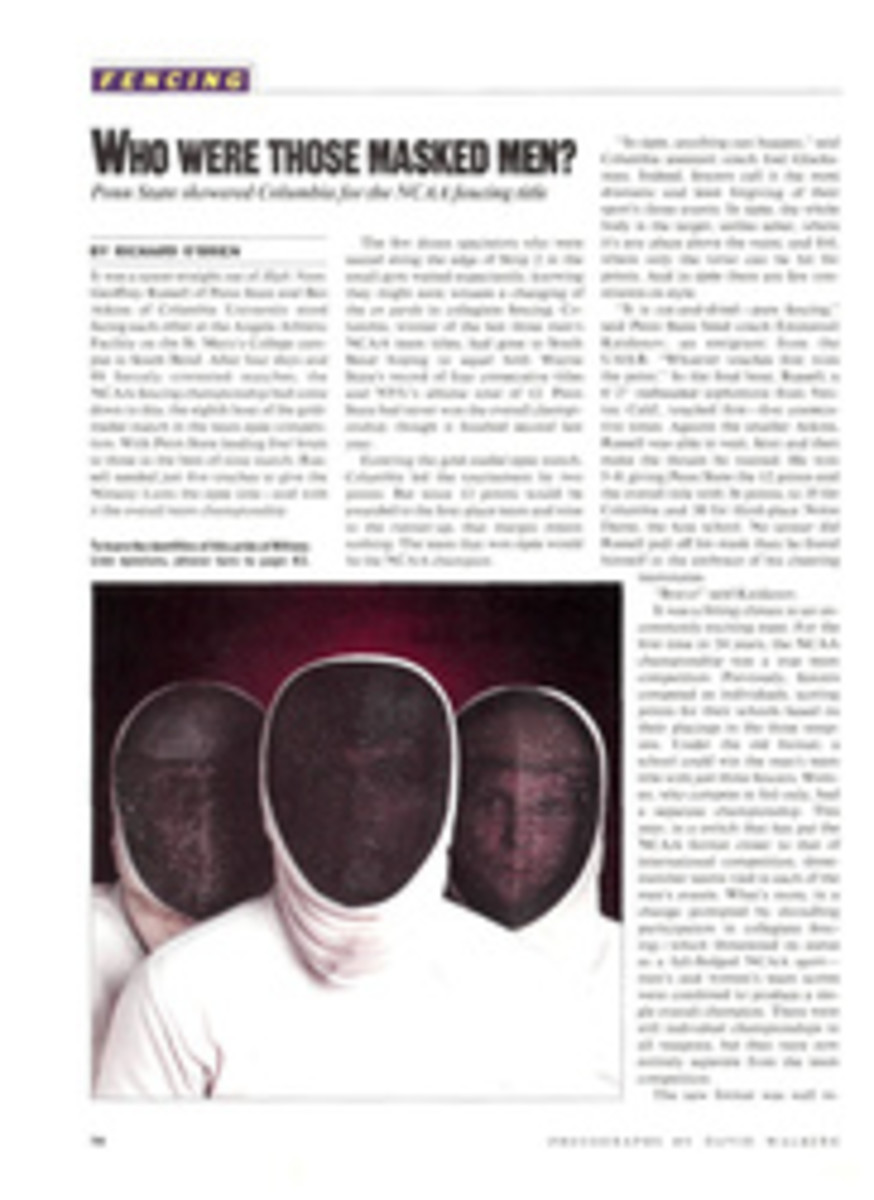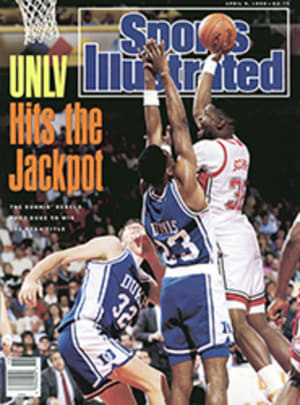
THE CARDINAL RULES
Four and a half years ago, tara VanDerveer awoke in a Knoxville, Tenn., hotel room while on her first cross-country recruiting trip as the women's basketball coach at Stanford. Her head throbbed from jet lag, and though it was September, the humidity outside was withering. VanDerveer put on her lucky cotton skirt, the one with gray and white stripes, drove 20 miles west to Oak Ridge and sat in a wing chair in the living room of Jim and Donna Azzi. Over a soft drink, she told the Azzis and their daughter Jennifer, then a high school All-America, that if Jennifer signed with Stanford, the Cardinal would win the national championship before she graduated. Under VanDerveer's predecessor the season before, Stanford had gone 9-19, but Jennifer eventually agreed to play for the Cardinal anyway. "Jennifer was like me," VanDerveer says. "She was a risk taker."
On Sunday afternoon, Jim and Donna drove the 20 miles from Oak Ridge to Knoxville, where they saw Jennifer's risk pay off—not to mention VanDerveer's presumptuous prediction come true. Before 16,595 fans at Thompson Boling Arena on the University of Tennessee campus, the 5'9" Azzi guided a high-octane, well-blended Stanford team to its first NCAA women's basketball title with an 88-81 triumph over Auburn. Though fellow guard Sonja Henning outscored her (21 points to 17), center Trisha Stevens outrebounded her (10 to four) and forward Katy Steding out-three-pointed her (six to four), Azzi was named the MVP of the Final Four. "She's the heartbeat of that team," said Auburn assistant coach Carol Ross. "That's why she deserved it."
Azzi also provided a fairy-tale plot line that was too touching to ignore: Local girl goes 2,500 miles west to attend a brainy college, returns home and wins hearts, honors and a national championship. "It is kind of like a storybook," said Azzi after the game.
Last Thursday, Woodland Elementary, Azzi's alma mater, sent a floral arrangement garnished with gingerbread men to her at the Cardinal's hotel in Knoxville. On Friday, while Stanford was defeating Virginia 75-66 in the semifinals, Azzi was announced as the winner of the Wade Trophy, which goes to the best senior player in the land. Then came Sunday's finale, followed by—yep—a trip to Oak Ridge, where Jim and Donna had the team, the band and 50 of the family's nearest and dearest friends over to the house for Domino's pizza. Mayor Roy Pruett stopped by, too—to drop off the key to the city.
Signing Azzi was the start of a recruiting bonanza for VanDerveer, 36, who had gone to Stanford from Ohio State. Since then she has reeled in blue-chippers from nine states and improved the Cardinal's record each year, from 14-14 in Azzi's freshman season to 32-1 in 1989-90. VanDerveer also kept reminding her troops of her prediction. Last fall the players put up posters around their locker room that read NCAA CHAMPIONS—GET COMFORTABLE WITH IT. "There was no doubt in our minds we would win it all from day one," says Stevens.
The Cardinal's first opponent in Knoxville was expected to be Tennessee—until Virginia toppled the Lady Vols 79-75 in overtime in the East Regional final. Tennessee's absence from the Final Four sparked anxiety. It mattered a lot to some of the leaders of women's college basketball that their showcase event had a chance to outdraw the men's Final Four because Thompson-Boling has a larger capacity than Denver's McNichols Arena (24,500 to 17,000). After losing, Tennessee launched a campaign that used local TV spots and 5,000 postcards to urge ticket holders to show up or at least give their seats to someone who would. Ultimately, Knoxville set a women's Final Four record with 39,490 paid customers. The turnstile count, however, lagged slightly behind Denver's for each session.
The Cavaliers' chances against Stanford depended on the play of their sophomore guards, Dawn Staley and Tammi Reiss. Staley is all Philadelphia slash and flash—"I try to get the job done in a quiet way like Maurice Cheeks, but my game gets out of hand," she says—while Reiss copied Azzi's all-around game. "She first caught my eye because she was a white girl playing a very savvy, fluent game," says Reiss, who has studied dozens of tapes of Azzi in action.
Reiss held Azzi without a shot for the first 11:10, but then Virginia coach Debbie Ryan, sensing Reiss was tiring, switched Staley on to Azzi. The move proved costly. With Stanford trailing 18-16, Azzi converted a driving, spinning bank shot and a three-pointer from the right wing. Then she sank a trey from the left. The Cardinal went in front 24-20 and never trailed again. Steding led Stanford's balanced attack with 18 points. Afterward, Azzi, who racked up 15 points, six rebounds and five assists, said, "The thing about this team is, if things aren't going well one way, there's always something else."
Auburn, on the other hand, had come to rely on one thing: tenacious pressure defense. The Lady Tigers had lost every first-stringer but junior forward Carolyn Jones from their Final Four teams of 1987-88 and '88-89 and had struggled through December looking for a cohesive starting combination. Coach Joe Ciampi finally decided to go with a small, quick lineup that stressed defense and to make 6'6" center Linda Godby, a potent scorer who had been starting, his first substitute off the bench. Auburn took off. Coming into the Final Four, the Lady Tigers were holding the opposition to 37.7% shooting with their hardnosed play. "We don't wear rhinestones on our gym shoes," said guard Evelyn Thompson. "We just play all 40 minutes and all 94 feet."
But even Ciampi's sliding 2-3 zone didn't figure to stop Louisiana Tech, the Midwest Regional champion, and its star, Venus Lacy. The 6'4" Lacy had started her career as a 220-pound sophomore who feasted on Snickers bars and who couldn't be depended on to show up in class or on the court, but she blossomed into a 190-pound senior who averaged 24.2 points and 12.7 rebounds while leading the Lady Techsters to a No. 1 national ranking and a 32-0 record coming into the Final Four.
However, for half of the first half against Auburn, Lacy was on the bench with two fouls, and the Lady Tigers pulled in front 43-23 just before intermission. Lacy, who wound up with 26 points and 15 rebounds, led a second-half Tech rally that cut the lead to 66-58 with 4:24 to go, but Jones made four free throws to seal an 81-69 Lady Techster loss, their first since Auburn beat Tech 76-71 in the semifinals last year.
Before the championship game, VanDerveer stressed to her players that they not only had to break the Lady Tigers' press but also had to attack their defense once past midcourt. Auburn, in turn, wanted to somehow stop a Stanford attack that was scoring 92.9 points a game. "We scouted them to see who played well in big games," said Ross. "Unfortunately, it was a different player every time."
Stevens provided the Cardinal's inside punch early, while Steding extended the Auburn defense with her three-point shooting. Steding arrived at Stanford with Azzi in 1986 as a 6-foot post player from Lake Oswego, Ore., but after her freshman season, VanDerveer moved her to forward. Steding suffered through what she calls "the ugly year," but gradually she developed the outside-shooting range that made her Stanford's toughest player to guard. She had 18 points, seven rebounds and five assists on Sunday. "I had a premonition," says VanDerveer. "I told Katy the first day of practice she had to be MVP of the national tournament." Had it been played in Lake Oswego, she would have been.
Auburn, trailing 22-11, suddenly found its stride. Jones went over and around Azzi for 14 of her title-game record 24 points in a 30-10 run that gave the Lady Tigers a 41-32 edge with 2:07 remaining in the half. Henning, however, answered with a pivotal play. She snapped up a loose ball from Thompson, sped down the court, made a running bank shot, despite being fouled, and nailed the free throw. After that Stanford scored six unanswered points to make the score 41-41 at the half.
Then, with the Cardinal clinging to a 48-46 advantage, Azzi took over the game. She fired a lead pass to Julie Zeilstra for a layup. She canned a pull-up jumper from 16 feet. Then she took an inbounds feed from Steding and buried a three-pointer to cap a 9-2 run. The Cardinal never looked back.
For VanDerveer, the win was an emotional one. Two days earlier she had wanted to protest the abolition of women's basketball at Oklahoma with a moment of silence before Sunday's tip-off (page 19). She has been a hoops junkie all her life—as an undergraduate at Indiana in the early 1970s, she spent her spare time observing Bob Knight's practices—but growing up in Albany, N.Y., she had not been able to play because her high school didn't have a girls' team. "[Loyola Marymount's] Hank Gathers died playing a game he loved," said VanDerveer last Saturday. "What people don't realize is that women love it just as much." In the end, she decided to display her feelings about the Sooners' abandonment by wearing a red ribbon—Oklahoma's colors are red and white—on her blouse.
Thanks to Azzi and Co., the title gave VanDerveer more pleasant thoughts to consider, as well as a new good-luck bauble for her right hand. "I couldn't wait to put it on," said VanDerveer of the championship ring, which should help make recruiting easier. "I sure will be happy to go into a living room now that I can show off this thing."
PHOTO
DAMIAN STROHMEYER
Auburn's normally sticky defense couldn't quite keep up with the hard-driving Azzi.
PHOTO
DAMIAN STROHMEYER
Had the Final Four been in Lake Oswego, not Knoxville, Steding might have been MVP.
PHOTO
DAMIAN STROHMEYER
On Friday, Auburn's Venus-flytrap D came at Lacy from all angles.

